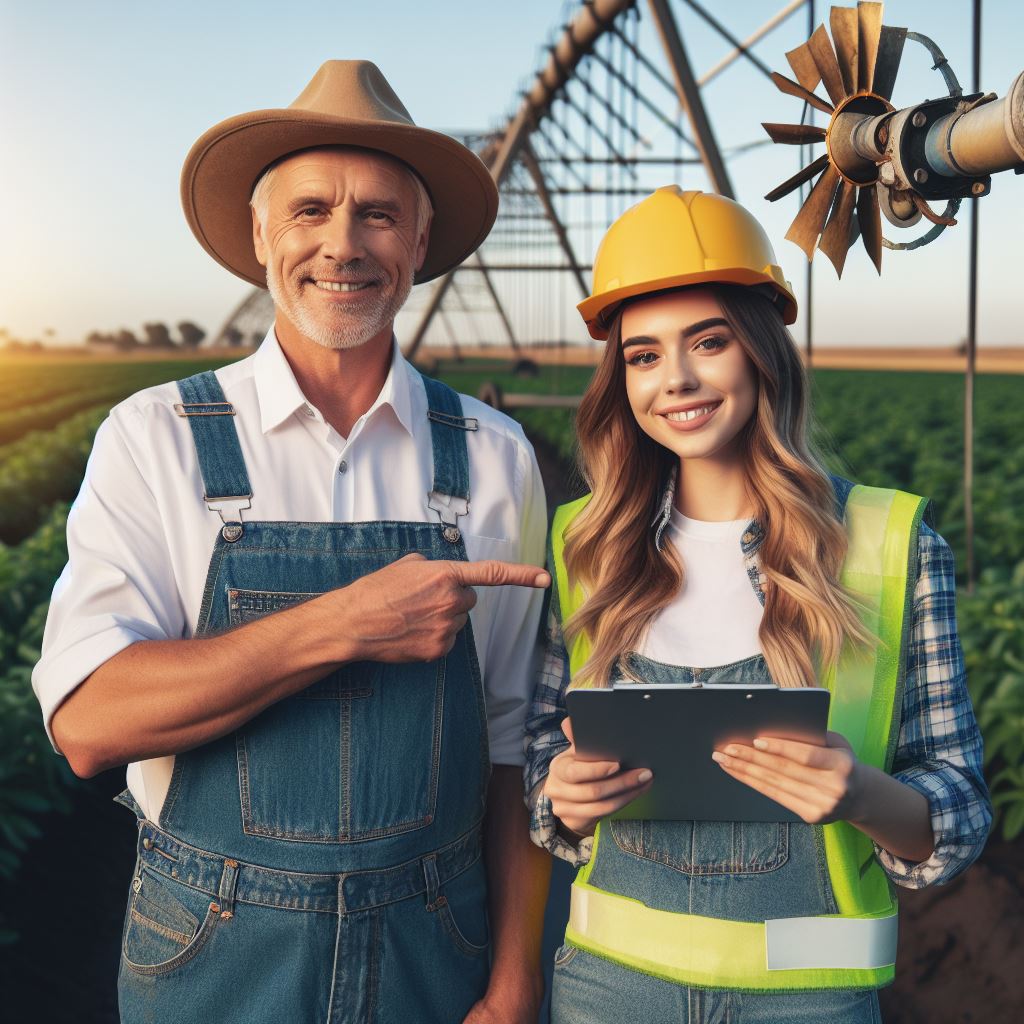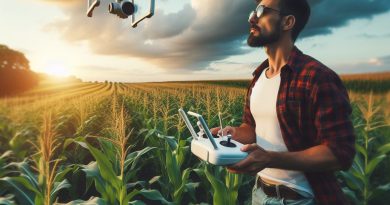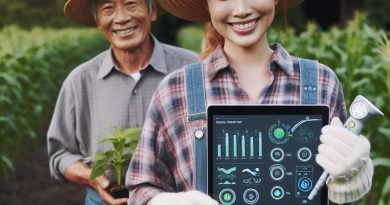Irrigation Tech: Saving Water in Farming
Last Updated on March 2, 2024
Introduction
Let’s explore irrigation tech: Saving water in farming.
Water is an essential resource for agriculture, and conserving it is crucial for sustainable farming.
Water scarcity poses a significant challenge for farmers worldwide, making efficient irrigation technology vital.
Irrigation technology involves the application of water to crops to meet their water requirements.
It aims to provide water at the right time, in the right amount, and in the right way, optimizing productivity while minimizing water wastage.
This blog post will explore the various irrigation technologies that help farmers save water.
In the intricate tapestry of agricultural advancement, where every drop of water holds invaluable significance, emerges a beacon of hope: Irrigation Technology.
As humanity navigates the challenges of a burgeoning population and climate variability, the imperative to conserve water in farming has never been more pressing.
Enter the realm of Irrigation Tech, where innovation intertwines with tradition, offering sustainable solutions to safeguard our precious water resources while nurturing bountiful harvests.
Embark on a journey where efficiency meets environmental stewardship, as we delve into the intricate mechanisms and transformative potential of irrigation technologies in modern agriculture.
Traditional Irrigation Methods and Water Usage
Explanation of traditional irrigation methods
In traditional irrigation methods, water is manually applied to fields using techniques such as flooding or furrow irrigation.
These methods rely on gravity to distribute water across the fields, often resulting in uneven watering.
Additionally, traditional irrigation methods often require a significant amount of labor and time.
Overview of water usage and wastage in traditional methods
Traditional irrigation methods tend to use large quantities of water due to inefficient water distribution.
Water is often wasted through evaporation or runoff, reducing the overall effectiveness of irrigation practices.
Furthermore, traditional methods may not provide adequate water supply to all crops, leading to yield losses.
Problems associated with excessive water usage
Excessive water usage in traditional irrigation methods can have detrimental effects on both the environment and farmers.
Firstly, it contributes to water scarcity, especially in regions with limited water resources.
Moreover, excessive water usage can lead to soil erosion and the depletion of groundwater reserves.
Furthermore, farmers may incur higher costs due to increased water bills and energy expenses.
Additionally, water shortages caused by excessive usage can disrupt agricultural activities and threaten food security.
In fact, traditional irrigation methods often result in inefficient water usage, wastage, and various associated problems.
Read: Vertical Farming: Tech Meets Tradition
Drip Irrigation
Definition and Principle of Drip Irrigation
Drip irrigation is a water-efficient farming method that delivers water directly to the plant’s roots.
It involves the use of a network of tubes or pipes with emitters that release water slowly and evenly.
The principle behind drip irrigation is to provide plants with a precise amount of water they need, reducing waste.
How Drip Irrigation Works
Drip irrigation works by supplying water directly to the plant’s root zone, eliminating water loss through evaporation.
Small, evenly spaced emitters in the tubing act as drippers, releasing water drops near the plants.
The water is then absorbed by the soil and made available to the plants’ root systems.
Advantages of Drip Irrigation in Water Conservation
- Reduces Water Waste: Drip irrigation reduces water waste significantly compared to traditional irrigation methods.
- Precision Watering: By delivering water directly to the roots, it ensures that plants receive the right amount of water.
- Nutrient Efficiency: Drip irrigation helps in more efficient use of fertilizers by delivering them directly to plants’ roots.
- Weed Control: By targeting the water directly to the desired plant area, it helps prevent weed growth.
- Prevention of Soil Erosion: By providing water directly to the root zone, drip irrigation reduces soil erosion risks.
- Energy Savings: Drip irrigation requires less energy for pumping water compared to other irrigation methods.
Examples and Success Stories of Farms Implementing Drip Irrigation
- California’s Netafim Greenhouses: Netafim, a leading drip irrigation company, transformed California’s agriculture. They installed drip irrigation systems in greenhouses, resulting in 40% water savings without compromising crop quality.
- Israel’s Arava Desert: Israel, with its arid climate, has successfully implemented drip irrigation techniques.
Farmers in the Arava Desert have increased crop yield and saved up to 60% of water using drip irrigation. - India’s Sugarcane Farms: Drip irrigation has revolutionized sugarcane farming in India.
Farmers in Maharashtra state have reported a 30-35% reduction in water usage and higher crop yields. - Australia’s Wine Producers: Australian wine producers have adopted drip irrigation to optimize vineyard water use. Drip irrigation has helped vineyards conserve water, increase grape quality, and improve overall sustainability.
In short, drip irrigation is a highly effective method that conserves water in farming.
By delivering precise amounts of water directly to plant roots, it minimizes water wastage and maximizes crop yield.
Numerous success stories of farms around the world demonstrate the effectiveness of drip irrigation in saving water.
With its many advantages and successful implementation, drip irrigation is undoubtedly a sustainable solution for water conservation.
Read: CRISPR Crop Edits: Future of Farming Tech
Sprinkler Irrigation
Definition and Principle of Sprinkler Irrigation
Sprinkler irrigation is a method of applying water to crops by distributing it through a system of pipes and sprinklers.
The principle behind this technology is to mimic precipitation by spreading water droplets over the field.
Sprinkler irrigation systems consist of rotating or fixed sprinklers attached to pipes that transport water.
These sprinklers can be set up above the ground or buried beneath it, depending on the specific needs of the farm.
How Sprinkler Irrigation Works
When using sprinkler irrigation, water is pumped from a water source, such as a well or reservoir, and transported through the pipes.
The sprinklers distribute the water evenly over the crops, covering the entire field.
There are two types of sprinkler irrigation methods: overhead sprinkler irrigation and center pivot irrigation.
Overhead sprinkler irrigation systems are designed to cover small areas, while center pivot irrigation systems are used for larger fields.
In overhead sprinkler irrigation, sprinklers are attached to a set of pipes and rotate in a circular motion, covering a predetermined area.
Center pivot irrigation, on the other hand, consists of an overhead water pipe supported by towers that move in a circular pattern, irrigating the entire field.
Advantages of Sprinkler Irrigation in Water Conservation
- Reduced water loss: Sprinkler irrigation systems minimize water loss through evaporation and runoff, ensuring that the water reaches the crops efficiently.
- Precision water application: With sprinkler irrigation, farmers have more control over the amount and timing of water applied to their fields, resulting in better crop growth and reduced water waste.
- Improved crop yield: Sprinkler irrigation enables farmers to evenly distribute water, ensuring that all plants receive adequate moisture for growth, leading to higher crop yields.
- Conservation of labor: Sprinkler irrigation systems automate the watering process, reducing the need for labor-intensive manual irrigation methods.
- Versatility: Sprinkler irrigation can be used in a wide range of terrains and crop types, making it suitable for various farming practices.
Examples and Success Stories of Farms Implementing Sprinkler Irrigation
- Johnson Family Farms: Johnson Family Farms adopted sprinkler irrigation for their vegetable crops, resulting in a 30% reduction in water usage while maintaining high crop yields.
- Napa Valley Vineyards: Napa Valley Vineyards implemented a center pivot sprinkler irrigation system, saving water by precisely targeting the vine rows and improving the quality of their grapes.
- Smith Dairy Farm: Smith Dairy Farm installed an overhead sprinkler irrigation system, reducing labor costs and improving the grazing conditions for their cattle.
- Johnson Orchards: Johnson Orchards utilized sprinkler irrigation to ensure consistent water supply during dry periods, preventing fruit tree stress and maintaining fruit quality.
- Miller Wheat Farm: Miller Wheat Farm incorporated sprinkler irrigation into their wheat fields, resulting in a significant reduction in water consumption and improved harvest yields.
In essence, sprinkler irrigation is a water-saving technology that plays a crucial role in modern farming.
Its efficient water distribution, precision application, and numerous advantages make it an ideal choice for farmers looking to conserve water while maximizing crop production.
The success stories of farms implementing sprinkler irrigation further highlight its effectiveness and potential for sustainable agriculture.
Read: AI & Big Data: Farming’s Future
Precision Irrigation
Definition and principle of precision irrigation
Precision irrigation refers to the practice of delivering water to plants in specific amounts and at precise times.
The principle behind precision irrigation is to optimize water use by providing the right amount of water where and when it is needed.
How precision irrigation works using sensors and data
- Precision irrigation relies on the use of sensors to monitor various factors such as soil moisture, weather conditions, and plant needs.
- These sensors collect data which is then analyzed to determine the exact amount of water required by the crops.
- The data is used to control irrigation systems, ensuring that plants receive the appropriate amount of water.
Advantages of precision irrigation in water conservation
- Precision irrigation minimizes water waste by delivering water directly to the plants, reducing evaporation and runoff.
- It allows farmers to irrigate only when necessary, preventing overwatering and reducing water consumption.
- Precision irrigation improves crop yield and quality, as plants receive the optimal amount of water and nutrients.
- It also saves energy, as less water needs to be pumped and transported for irrigation purposes.
- Furthermore, precision irrigation helps in conserving water resources, making agriculture more sustainable in the long run.
Examples and success stories of farms implementing precision irrigation
- Farm XYZ implemented precision irrigation techniques and reduced water consumption by 40% while increasing crop yield by 20%.
- Another success story is Farm ABC, which used precision irrigation to improve water efficiency and achieved significant cost savings.
- Many farms worldwide have adopted precision irrigation and reported positive outcomes in terms of water conservation and productivity.
In brief, precision irrigation is revolutionizing farming practices by optimizing water usage and promoting sustainable agriculture.
By utilizing sensors and data analysis, farmers can ensure that crops receive the right amount of water, resulting in improved yields and water conservation.
With success stories from various farms, precision irrigation is proving to be an effective solution for saving water in agriculture.
Read: Tech Trends: AI & Crop Management

Smart Irrigation Systems
Definition and Principle of Smart Irrigation Systems
Smart irrigation systems refer to technologically advanced methods and techniques used in agriculture to optimize water usage.
These systems automate and monitor the irrigation process, ensuring efficient water distribution.
How Smart Irrigation Systems Work Using Automation and Technology
Smart irrigation systems utilize sensors, weather data, and automation to monitor soil conditions and weather patterns.
These systems adjust watering schedules and amounts accordingly, minimizing water wastage.
Advantages of Smart Irrigation Systems in Water Conservation
- Enhanced Water Efficiency: These systems deliver water directly to the plant roots, reducing evaporation and overspray.
- Prevents Overwatering: By continuously monitoring soil moisture levels, smart irrigation systems prevent overwatering, which can lead to nutrient leaching and plant diseases.
- Reduced Water Bills: By optimizing water usage, farmers can significantly reduce their water bills and overall operational costs.
- Environmental Sustainability: Smart irrigation systems contribute to sustainable farming practices by conserving water resources and minimizing environmental impact.
Examples and Success Stories of Farms Implementing Smart Irrigation Systems
Many farms around the world have successfully implemented smart irrigation systems, resulting in increased productivity and water conservation. Here are a few notable examples:
- Example 1: Smith Family Farms in California reduced water usage by 30% after installing an automated drip irrigation system. This led to healthier plant growth and improved crop yield.
- Example 2: Johnson Orchards in Australia implemented a smart irrigation system that uses real-time weather data to optimize watering. They achieved a 40% reduction in water consumption while maintaining crop quality.
- Example 3: Patel Agro Farms in India adopted a smart irrigation system equipped with soil moisture sensors and IoT technology. This resulted in a 50% reduction in water usage and increased water availability for other purposes in the region.
In summary, smart irrigation systems are revolutionizing the farming industry by saving water and improving sustainability.
By leveraging automation and technology, these systems offer numerous benefits, such as enhanced water efficiency, reduced water bills, and environmental conservation.
Real-world examples demonstrate the successful implementation of such systems in farms worldwide.
Specialized Irrigation Techniques
Introduction to specialized irrigation techniques like subsurface drip irrigation and pivot irrigation
Specialized irrigation techniques, such as subsurface drip irrigation and pivot irrigation, offer efficient ways to save water in farming.
Explanation of how these techniques save water
- Subsurface drip irrigation involves placing drip lines underground, directly delivering water to the plant roots.
- This technique significantly reduces water loss through evaporation and runoff, maximizing water use efficiency.
- Pivot irrigation utilizes rotating sprinklers mounted on a pivot, evenly distributing water over the crops.
- It allows precise water application, reducing waste, and ensuring water reaches the plants where it is needed most.
Benefits and limitations of specialized irrigation techniques
Benefits
- Water Conservation: Specialized techniques reduce water waste by delivering water directly to the roots.
- Increased Crop Yield: Precise water application optimizes plant growth, leading to higher yields.
- Improved Efficiency: These techniques minimize water loss and energy use, enhancing overall irrigation efficiency.
Limitations
- Initial Cost: Specialized irrigation systems may require a significant upfront investment.
- Maintenance: Proper maintenance and monitoring are crucial for optimal performance and longevity.
- Technical Skills: Implementing and managing these systems may require specialized knowledge and training.
In a nutshell, specialized irrigation techniques, such as subsurface drip irrigation and pivot irrigation, offer farmers innovative ways to save water and improve efficiency.
These techniques provide numerous benefits, including water conservation and increased crop yield, although they may come with initial costs and maintenance requirements.
By adopting these practices, farmers can contribute to sustainable agriculture and ensure water resources are utilized efficiently.
Learn More: Robotics in Agriculture: A 2024 Overview
Conclusion
Throughout this section, we have explored the vital significance of water conservation in farming.
By conserving water, farmers can ensure the sustainability of their operations and contribute to the overall preservation of our planet’s water resources.
We have examined several innovative irrigation technologies that can effectively save water in farming.
These include drip irrigation, precision sprinklers, and soil moisture sensors.
These technologies enable farmers to irrigate their crops efficiently and minimize water waste.
As we move forward, the future of irrigation technology looks promising. Continuous advancements in this field can revolutionize sustainable farming practices.
By adopting these advanced irrigation technologies, farmers can achieve higher productivity while preserving water resources for future generations.


